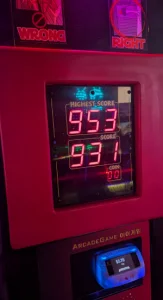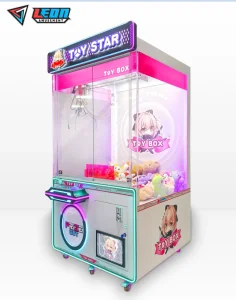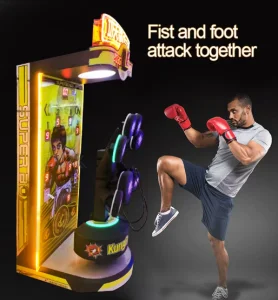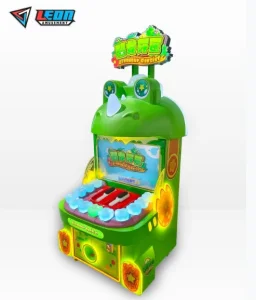Setting up a low-cost, high-return claw machine store involves selecting affordable yet reliable machines, typically priced between $500 to $2,000 each. Placing them in high-traffic locations such as malls or entertainment centers can generate $200 to $1,000 per machine monthly.Keep operational costs low by optimizing machine placement and performing routine maintenance to reduce downtime. With minimal staff required, stores can achieve profit margins of 50-70%, ensuring a quick return on investment within 6-12 months.
Table of Contents
ToggleImportance of Location Selection
Take shopping malls as an example, weekend foot traffic often reaches 5000 people per day, with each person spending an average of about 5 RMB, leading to monthly revenue of at least tens of thousands. The rent for a shop with an area of 30 square meters is around 6000 RMB per month, plus water and electricity property costs, totaling about 10,000 RMB per month. In pedestrian streets, the per capita consumption is about 4 yuan with a high season daily foot traffic of 3000, resulting in monthly revenue of 36,000 RMB. After deducting rent and other costs, the net profit can reach as high as 50%. Locations near schools are also ideal, with daily foot traffic of nearly 2000 people, each spending about 3 yuan, generating monthly revenues of around 18,000 RMB. Due to relatively low rental costs, rent expenses are about 6000 yuan, resulting in lower profits.
If you open your store in a mall, it helps to find one near cinemas or dining areas (assuming peak foot traffic). Take a claw machine store near the cinema in a certain mall as an example, with 7000 people on weekends, each spending an average of 6 RMB, generating weekend income of tens of thousands of yuan. For pedestrian streets, stores can also be located near traffic intersections such as subway exits. A claw machine store near a city subway exit, with daily foot traffic of 4000 people and an average spending of 4.5 yuan per person, was able to earn monthly revenues as high as 54,000 RMB (gross profit), leaving about 30,000 RMB/mo in net profits after other expenses.
Special projects also have special situations, with stores near middle schools or universities having more potential. A claw machine store near a university, with daily traffic of 2500 people, can generate monthly income in the tens of thousands, with higher profits after deducting rent costs. Another good choice is to open stores near training institutions or tutoring centers, where there is a high concentration of students with a strong interest in claw machines and low-cost college labor available after classes. For example, a store near a training institution with a daily traffic of 1500 people can reach monthly revenue of tens of thousands of RMB, with high profits after removing costs.

Equipment Selection
High-quality claw machines with a long lifespan cost about 3000 yuan each and can last up to 5 years, running daily for an average of about 10 hours; the annual operating cost is approximately 1 minute of energy consumption per hour. If you spend a total of 30,000 yuan to buy these 10 machines, you can earn 500 RMB per day, recovering the investment within two months. For example, choosing lower-cost equipment with higher maintenance frequency increases monthly costs by 500 yuan, resulting in increased total costs. Market surveys show that low-quality equipment has an average downtime of 20 hours per month, impacting revenue by approximately 20,000 yuan (thus, selecting cost-effective equipment is advisable).
To attract people to stop, you can also add 3 more gashapon machines at the cost of 10,000 RMB each, bringing in an extra daily revenue of 1820 RMB. The equipment costs 3000 yuan, but the daily net income plus operation and maintenance costs is at least 600 yuan, thus increasing monthly revenue by about 18,000 RMB. A variety of equipment configurations can improve retention time and payment effectiveness.
The lifespan and management of equipment also matter. High-quality equipment requires about 100 yuan per month for maintenance, with annual maintenance expenditure totaling roughly 1200 yuan. Low-quality equipment requires 500 yuan per month for maintenance, with high-power consumption costing 6000 yuan annually. Selecting high-quality equipment ensures that monthly maintenance fees do not exceed 1000 RMB, reducing downtime caused by failure and improving overall operational efficiency.
Using energy-efficient claw machines is also a cost-effective way. A normal claw machine uses 0.5 kWh per hour and runs for 10 hours a day, resulting in an electricity fee of about 150 yuan each month; energy-saving machines use only 0.3 kWh per hour, saving significant costs. If the monthly running time reaches 300 hours, the electricity cost can save hundreds of yuan. Calculated from 10 machines, just the electricity cost per month will save you 600 yuan, an overall saving of nearly 7200 yuan annually.
The design and functionality of claw machines need to consider customer experience. For example, some stores have added flashing lights and music functions to attract more young customers. Each machine can bring an additional daily income of 50 yuan, with 10 such machines adding a monthly turnover of 15,000 RMB. Moreover, machines that are too difficult to operate adversely affect customer satisfaction – high-quality machines have double the success rate of lower-quality ones. Increased grab success rates lead to better customer satisfaction and a higher number of returning customers. One store saw its return customer rate rise from 20% to 35%, increasing monthly revenue by about 20%.

Marketing Strategies
Promoting on WeChat, Weibo, and TikTok with 1-2 posts per day can attract a minimum of 50 new customers, each spending around 5 yuan, resulting in additional monthly revenue of several thousand yuan. One store increased its monthly revenue by 20% using this type of social media promotion strategy.
Establishing a paid membership system also helps increase income. Offering 10 yuan for every 100 yuan recharged can attract new members each month, increasing exposure; monthly income can exceed an additional 5000 yuan. One successful case involved adding an intelligent electric workshop with daily membership automation to the store, increasing the number of monthly members by 100, each paying 150 yuan/month, adding revenue of 7500 RMB. Monthly charging activities attracted 200-300 people each month, increasing revenue by 10,000 to 15,000 yuan.
Partnering with nearby stores for joint promotions is a great way to amplify awareness and bring more customers through your door. For example, cooperating with neighboring restaurants on a monthly basis, pulling 100 people into their stores (providing food before they go), adds up to 5 yuan for each customer, forming new revenue of 5000 yuan every month. One claw machine store in China teamed up with three neighboring stores, securing 150 more monthly customers, increasing revenue by 20,000 yuan.
Hosting themed events can drive social engagement and increase foot traffic. A store that holds a monthly themed event, such as holiday special promotions or anime-related events, can gather many young people, increasing revenue by about 8000 yuan per event. Data analysis revealed that themed events increased customer dwell time by around 30%, and average spending per head grew by approximately 25%.
Claw machines need to be restocked with new prizes regularly. The store updates prizes every two weeks, adding popular IP characters to attract customers, increasing revenue by around 15% per visit during the first two weeks after the new ‘toys’ became available. Monthly revenues increased roughly by 20%. According to surveys, 70% of customers preferred novelty rewards – another way to increase foot traffic and customer satisfaction in the store.
Advertising in local buses and subway stations can also bring in extra customers. A store spending 2000 yuan per month on such ads attracted an additional 500 customers, each spending about 5 yuan, increasing monthly sales by 2500 yuan, with net profit increasing by 500 yuan after deducting ad costs. Data also highlighted the long-term effects of such advertising, with increases in brand awareness and customer numbers steadily rising.

Cost Control
Renovation costs per square meter are 500 yuan, and the average store size of 30 sqm requires 15,000 yuan for decoration. Using second-hand renovation materials can reduce the total cost by 30%, to 10,500 yuan. One store used second-hand materials, reducing total renovation costs to 8000 yuan, saving almost half the decoration costs.
Using energy-efficient claw machines can save costs. Normal claw machines consume 0.5 kWh per hour, running for 10 hours daily, costing about 105 yuan per month in electricity; energy-saving machines cost only half as much, consuming 0.3 kWh per hour. In China, with high standards, the monthly electricity cost can be just 90 yuan. This means saving 600 yuan per month in electricity costs, totaling 7200 yuan annually. In the example above, a store switched to energy-efficient equipment, reducing annual electricity costs from 18,000 yuan to 10,800 yuan, saving 40%.
Flexible staffing is necessary to manage labor expenses. Employees are scheduled based on customer traffic, with 2 employees working daily, each earning 3000 yuan per month, totaling 6000 yuan monthly. Proper scheduling can cut 20% of this expense, costing just about 4800 yuan per month. For example, a shop with only 1 employee scheduled off-peak weekdays and increased to 3 employees during weekend peak hours decreased its monthly labor costs from 6000 yuan to 5000 yuan, saving 17%.
Good inventory management can reduce operational costs. For example, a store with a monthly prize procurement
cost of 10,000 yuan reduced this to 8000 yuan by carefully selecting prizes based on customer preferences and avoiding unpopular ones, saving roughly 1200 yuan per month (about 20%). Implementing Just-in-Time inventory management, one store reduced the frequency of procurement from monthly to weekly, lowering total inventory and storage costs by 500 yuan.
Using intelligent management systems can also save costs. A store with a smart sales and inventory management system pays 500 yuan per month. The system optimized monthly operations, increasing efficiency by 20% and revenue by 15%, with net monthly profits up by more than 3000 yuan. The system significantly reduces human errors and time costs, enhancing overall operational efficiency.
High-quality equipment requires around 100 yuan per month for maintenance, with annual maintenance costs just over 1200 yuan. Low-quality equipment requires 500 yuan per month for maintenance, totaling 6000 yuan annually. Choosing high-quality equipment limits monthly maintenance costs within 1000 yuan, reducing downtime and improving efficiency.
Negotiating rent can also save money. A store in a mall (monthly rent of 6000 yuan) negotiated a half-month discount rate for the first six months, paying only 3000 yuan per month, saving 18,000 yuan over six months. These savings can be invested in other important operating expenses like business expansion.




